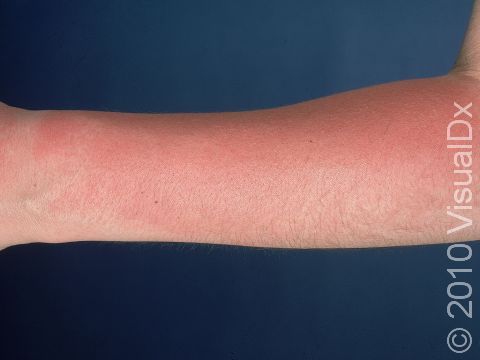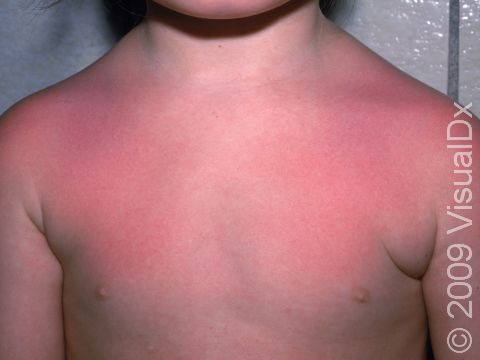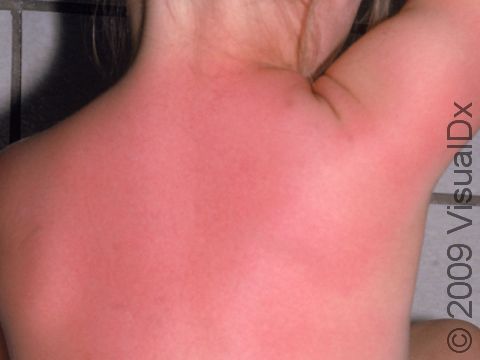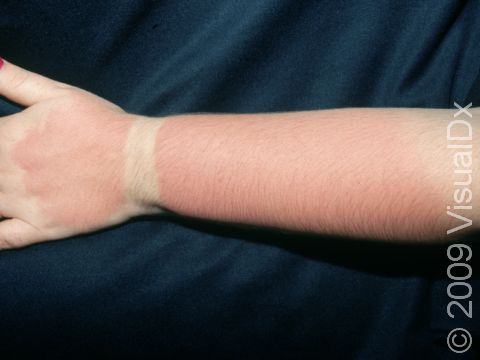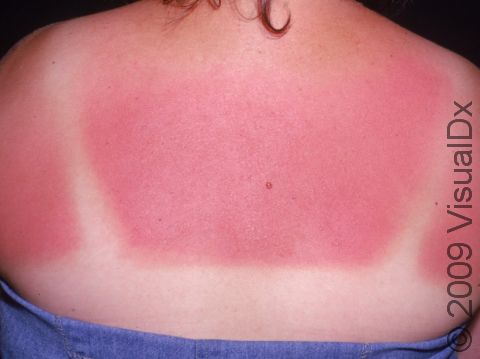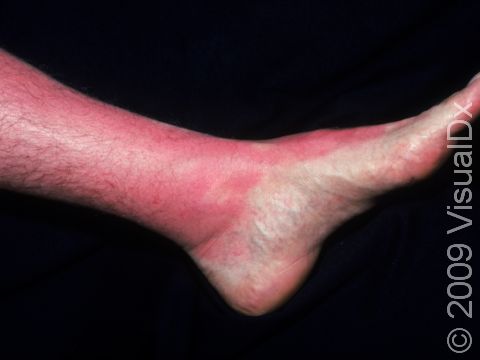Sunburn
Sunburn is caused by the skin’s reaction to ultraviolet light exposure from the sun. It appears around 4 to 24 hours after the exposure. The affected skin is red and may be painful or blistered. When sunburn starts to subside, peeling of the skin may be seen.
Some medical conditions as well as some oral medications may make the skin more sensitive to sunburn.
Getting a sunburn raises the lifetime risk of developing skin cancer.
Who's At Risk?
Sunburn occurs in people of all ages, particularly in individuals with lighter skin colors. People with darker skin colors have more pigment (melanin), which is protective, but sunburn and/or tanning can occur, except in the darkest skin colors, and no one is immune to developing skin cancer.
Signs & Symptoms
Sunburns may occur on any sun-exposed area. A sunburn appears as immediate redness as soon as 4 hours after exposure, followed by deep redness and blister formation in severe situations. Long-lasting redness may be present for weeks after the actual burn.
Self-Care Guidelines
If your child has a sunburn, further direct sun exposure should be avoided for a few days. Cool water or cool milk soaks may help soothe the affected areas. Acetaminophen (Tylenol) and ibuprofen (Advil, Motrin) can help decrease the redness and pain associated with sunburn. Make sure to have the child drink lots of fluids.
Applying a greasy cream or ointment to your child’s sunburn may actually make the pain worse by trapping heat on the skin.
Do not attempt to break any blisters that may form; you can cover them with gauze, if necessary. If any blisters break on their own, a topical antibiotic ointment (eg, Neosporin) can be applied. If the skin peels from a sunburn, a moisturizer can help with dry, peeling skin. Avoid applying topical products that end in “caine,” such as lidocaine, as they can sometimes further irritate the skin.
To reduce the risk of skin cancer later in life, it is important to prevent sunburns. Have your child:
- Avoid direct sun in the middle of the day (10 AM to 3 PM). Be mindful that snow and water reflect light to the skin. Additionally, clouds still let a lot of light through, so your child may still be exposed to ultraviolet light even on cloudy days.
- Wear a hat with a wide brim. A baseball cap does not provide as much protection.
- Cover up with tightly woven clothing. Some manufacturers make specialty clothing with an ultraviolet protection factor (UPF) rating.
- Use sunscreen on all exposed skin areas, including the lips, before going outdoors. A broad-spectrum sunscreen (that is, one that blocks UVB and UVA light) with an SPF of at least 30 is best. Apply sunscreen generously 30 minutes before going outdoors, and reapply every 2 hours or after swimming or sweating a lot. Sunscreen sprays tend not to provide a thick enough layer on the skin. Therefore, sunscreen lotions or creams are recommended.
Familiarize yourself with the moles, freckles, and other marks on your child’s body so that you can look for any changes in them, including shape, size, color, and other changes, such as bleeding or itching.
Treatments
Usually, a sunburn does not require a health professional’s care. However, if the child’s sunburn is accompanied by a fever, chills, nausea, vomiting, or they are feeling faint, see their health professional, as that may indicate heatstroke. Additionally, if the child is burned over a large portion of their body, they may require medical attention. Also seek medical advice if there are signs of infection (such as swelling, pus, or blisters that turn yellow or red).
Severe sunburns or blistering of the skin necessitate the attention of a health professional immediately. Prescribed treatment may include intravenous fluids, topical care, and dressings to speed healing and reduce infection, medicine to relieve pain, and sometimes topical steroid lotions or creams, or systemic steroids to reduce inflammation.
Visit Urgency
See your child’s health professional for evaluation if they have severe discomfort and inflammation with a sunburn.
References
Bolognia J, Schaffer JV, Cerroni L. Dermatology. 4th ed. Philadelphia, PA: Elsevier; 2018.
James WD, Elston D, Treat JR, Rosenbach MA. Andrew’s Diseases of the Skin. 13th ed. Philadelphia, PA: Elsevier; 2019.
Kang S, Amagai M, Bruckner AL, et al. Fitzpatrick’s Dermatology. 9th ed. New York, NY: McGraw-Hill Education; 2019.
Paller A, Mancini A. Paller and Mancini: Hurwitz Clinical Pediatric Dermatology. 6th ed. St. Louis, MO: Elsevier; 2022.
Last modified on March 9th, 2023 at 5:38 pm

Not sure what to look for?
Try our new Rash and Skin Condition Finder
